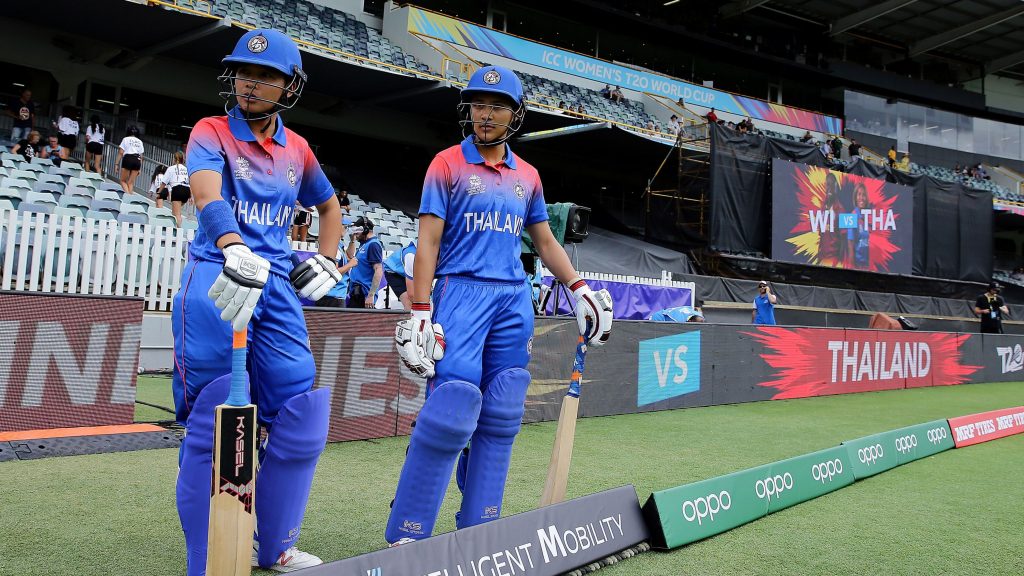
If cricket is the cultural lingua franca of the British colonial project, then English remains the sport’s language of choice. Predictably and understandably, and even more so for a tournament held in Australia, everything from the anti-corruption briefings to the post-match interviews at the T20 World Cup took place in English, yet another hurdle for the Thailand players.
Almost everyone spoke and understood English.
It appeared to be the individual cricket board’s responsibility to arrange interpreters and translators during the tournament. This did not surprise me. Roughly the same ten Commonwealth nations participated at each World Cup. Why would translators and interpreters even be on the organisers’ agenda?
The Thai players are fluent in Thai and a number of other languages, but not necessarily in English. They understand the importance of English to the sport and work hard to learn it in their spare time. During the tournament, and sometimes even on game days, Nattakan Chantham and Naruemol Chaiwai would query the meaning of an English word they had heard somewhere. The players also take great pains to speak English correctly in public engagements. On numerous occasions before an interview, players would want to discuss possible questions, brainstorm answers, and practice appropriate ways of articulating these answers in English.
Shan Kader, the ever-present bilingual team manager, was saddled with the responsibility of translating and interpreting at every public engagement, in addition to his other duties. These responsibilities even extended to complex, tactical discussions between the coaching staff and the players. When we talked before the tournament about the possibility of finding a bilingual media professional to take on the translating and interpreting role for the tournament, Kader made a good point. How many local translating and interpreting professionals understand the intricacies of this sport well enough to take on this task at a World Cup?

Every player who went before the cameras adapted well to the demands of live interviews and press conferences. They smiled, they joked, and they clawed their way through challenging questions about losses and tactics.
At times the depth of players’ knowledge about the game and the nuance of their responses could be lost in the imperfect art of translation and the heat of the moment. But this was part and parcel.
Match commentators and interviewers were almost always aware of the fact that they were professional communicators conversing in their language of choice with a group of professional cricketers conversing in a second language. Alan Wilkins, Ian Bishop, Mel Jones, and others would share their questions with the players before the on-field interviews began, allowing Shan a few minutes to translate them, mull over the answers in Thai and English, and pick one or two key phrases to ground the response.
At other times, verbal communication in English was unnecessary, and possibly constraining. Indeed, it was because of a miscommunication that the impromptu dance-off during the rain interval against Pakistan happened.
An ICC TV production crew approached the players’ dugout, as they often did. They asked me if one of the players would be willing to explain the team’s collective cheer after each boundary. I walked over to Sornnarin and passed on the request in English. My own Thai language skills are rusty at best, non-existent at worst and I am not sure they understood exactly what I was saying. Wongpaka Liengprasert, Sornnarin Tippoch, and Ratanaporn Padunglerd decided to freestyle dance for the cameras instead, and the rest is history. For the record, the cheer – yiiam jing jing – translates to something like ‘truly excellent’ or ‘fantastic.’
Of course, the sport itself transcends the English vernacular by transforming the meanings of words, and creating a parallel linguistic code for its participants.
Pre-tournament, each team participated in a series of promotional activities, to be used in the ICC’s social media coverage. One of the activities in which the Thailand women participated was called ‘Cricket Pictionary.’ Teams were given cricketing terms – for example fielding positions – and asked to draw clues for teammates to guess them. ‘Silly point’ was one of the phrases in question. The term ‘silly point’ is a combination of two common English words, with no meaning as a combined phrase, except in the world of cricket.
Here, English fluency mattered little. Sornnarin and Chanida dealt with the challenge ruthlessly and efficiently by drawing a field with a dot where the silly point fielder normally stands.
If you missed par one of Nishadh’s special, catch up with it here!
Keep up with news and events happening in the emerging game through our Facebook and Twitter pages.
Looking for audio content on the emerging game? Add the Emerging Cricket Podcast to your favourites on Apple, Spotify and Podbean.
Want extra Emerging Cricket content? Contribute to the Emerging Cricket Patreon cause from as little as $2 a month. Sign up here!






